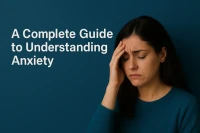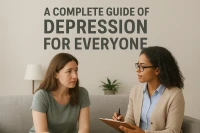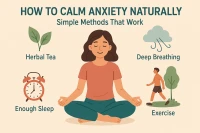The 3-3-3 Rule is an easy grounding technique. It helps calm anxiety. Just name three things you see, three sounds you hear, and move three body parts. This method uses your senses to bring you back to the present. It interrupts anxious thoughts and helps you regain control when stress hits.
The 3-3-3 Rule for anxiety helps you focus on your senses. To use it, identify three things you can see, three things you can hear, and three things you can touch. This technique shifts your attention from racing thoughts and physical symptoms. Mental health experts often suggest this grounding technique. It's quick, requires no special gear, and you can do it anywhere, even when no one is watching.
Medical Disclaimer: This article provides educational information about anxiety management techniques. It is not a substitute for professional mental health care. If you have severe anxiety, panic attacks, or other mental health problems that disrupt your daily life, reach out to a qualified healthcare professional.
Understanding Anxiety
How Anxiety Affects Focus and Mental Clarity
Anxiety is how the body reacts to stress or danger. It triggers the fight-or-flight response. Generalized anxiety happens when this response is triggered too often or strongly, even without real threats. The National Institute of Mental Health reports that about 31% of adults will experience anxiety disorders at some point in their lives.
When anxiety strikes, the brain prioritizes threat detection over other functions. It makes it hard to concentrate. Thoughts race between worries. Simple decisions become tough. You may feel mentally foggy or confused. Clinical observations show that cognitive symptoms can distress people just like physical signs of anxiety.
Common Symptoms Making Grounding Techniques Helpful
Symptoms that improve with grounding techniques include:
- Racing heart and rapid breathing.
- Muscle tension, especially in the shoulders and jaw.
- Sweating or feeling hot, even in cool temperatures.
- Dizziness or unsteadiness.
- Trouble focusing on tasks or conversations.
Therapists often teach grounding methods. These methods provide quick, practical tools for handling uncomfortable experiences.
Anxiety symptoms happen when adrenaline and cortisol fill your body. These hormones get you ready for action. This response keeps us safe from real danger. It can also cause distress when anxious thoughts set them off, not real threats. Understanding stress and anxiety helps you know when to use grounding techniques, like the 3-3-3 Rule.
Why Anxious Thoughts Spiral
Anxiety spirals in a cycle. Anxious thoughts lead to physical symptoms. These symptoms then make worry worse. Noticing your heart racing can make you think something is wrong. This thought increases anxiety, which then makes your heart race even faster. This feedback loop can rapidly escalate moderate anxiety into panic.
Cognitive behavioral therapy research shows that anxious thoughts often include:
- Catastrophic thinking patterns
- Overestimating danger
- Underestimating coping skills
- Focusing on possible threats
These patterns can make anxiety worse.
These thinking patterns can keep anxiety going and even make it worse. So, techniques that break this cycle are very helpful.
What Is the 3-3-3 Rule for Anxiety?
Definition and Origins of the Technique
The 3-3-3 Rule helps with anxiety. It teaches you to:
- Name three things you see.
- Identify three sounds you hear.
- Move three different body parts.
This sensory exercise shifts focus from anxious thoughts to the present. It encourages you to observe deliberately.
Mental health experts developed this grounding technique. They drew on cognitive-behavioral therapy and mindfulness. The method gained popularity because of its simplicity and effectiveness. The 3-3-3 Rule is easy to learn. Anyone can use it in a few minutes. Unlike complicated relaxation methods, this one is simple and quick.
Purpose and Benefits of Sensory Grounding
The 3-3-3 Rule calms the mind by shifting focus. You notice three things you can see, then three sounds you can hear, and finally, three things you can touch. This helps move attention away from anxiety and back to the present. When you pay close attention to what you see, hear, and feel, your brain moves away from anxious thoughts. Instead, it focuses on real details around you.
Grounding techniques work because the brain has a limited capacity for attention. You can't fully worry about the future and pay attention to the present at the same time. The 3-3-3 Rule grabs your attention. It uses sensory awareness to break the cycle of anxiety. Clinical experience shows this shift can provide quick, but temporary, relief from strong anxiety.
Step 1: Identify Three Things You Can See
Using Visual Awareness to Shift Focus
To use visual grounding, start by looking around. Name three specific objects you see. Choose items with details you can describe, such as "a blue coffee mug with a white handle" rather than "a mug." The more you observe, the better you engage your visual processing. This helps shift your focus away from anxious thoughts.
Therapists recommend varying what you choose to notice. Look for colors, textures, shapes, or patterns. You might see the rough texture of the brick wall, the smooth surface of the desk, or the shadow patterns on the floor. This detailed observation requires sufficient mental focus to displace anxious rumination temporarily.
How Visual Grounding Reduces Overstimulation
Visual grounding helps reduce anxiety by narrowing and focusing attention. During anxiety, people often feel overwhelmed. Their attention gets scattered across many worries at once. Focusing on specific objects gives the mind a clear task. This helps to calm an overstimulated brain.
Research shows that anxious people pay more attention to possible threats. They often overlook neutral details in their surroundings. Observing neutral surroundings can train your attention. This practice may help reduce anxiety vulnerability over time, according to clinical studies.
Step 2: Identify Three Sounds You Can Hear
How Sound Recognition Brings You to the Present
To relieve anxiety, listen closely to your surroundings. Name three different sounds you hear. Sounds can be obvious, like traffic or chatter. But they can also be subtle. You might not notice the hum of the air conditioning, birds chirping, or your own breathing.
Mental health experts often find that awareness of sounds is helpful. Sounds only happen in the present. Sounds are different from visual objects. While you can see things all the time, sounds appear and disappear. You need to be present to notice them. Sound awareness helps ground you, especially when anxiety pulls you toward future worries.
Sensory Processing and Calmness
Sound awareness lowers anxiety by activating auditory processing areas. This helps distract from the rumination networks that keep anxiety going. Neurological research shows that processing sensory information activates brain areas. These areas compete with systems that generate worry for neural resources.
The practice of identifying sounds also introduces a meditative quality. Quiet your mind to hear subtle sounds around you. This creates a calm moment of focus. Many people find sound identification soothing. This may be because it resembles the attentive listening we do in quiet, safe spaces.
Step 3: Move Three Parts of Your Body
Physical Grounding and Body Awareness
Moving body parts for anxiety fits the 3-3-3 Rule. It adds physical action to sensory observation. Simple movements are effective. Try wiggling your toes, rotating your shoulders, or stretching your fingers. You can also roll your ankles or turn your head from side to side. The movements should be deliberate and noticeable, but not large or vigorous.
Physical movement serves many functions in anxiety management. It eases muscle tension from anxiety. It shows you can take control when anxiety makes you feel helpless. Plus, it boosts proprioception, which is your body's sense of position and movement. Clinical observations show that body awareness helps people feel more grounded. It also makes them feel less detached during anxiety.
Why Small Movements Regulate the Nervous System
Movement can calm anxiety. This occurs through the connection between physical action and our nervous system. Gentle, slow movements tell your brain that the emergency is over. This helps switch from the fight-or-flight response to the rest-and-digest state.
Research on embodied cognition demonstrates that physical states influence mental states bidirectionally. Anxiety causes physical tension. By relaxing your muscles and moving gently, you can signal safety to your brain. This helps lower anxiety intensity. The 3-3-3 Rule's movement component capitalizes on this mind-body connection to relieve anxiety.
Why the 3-3-3 Rule Works
Psychological Reasoning Behind Grounding
The 3-3-3 Rule can help during panic attacks. This method is based on principles of cognitive-behavioral therapy. It encourages you to identify three things you see, three things you hear, and three things you feel. This grounding technique helps reduce anxiety and brings focus back to the present. The technique interrupts anxiety by shifting focus from scary thoughts. It engages multiple senses at once. This helps create a structured task that feels manageable during tough moments.
Mental health professionals explain that anxiety thrives on abstract, future-focused worry. Grounding techniques counter this by forcing concrete, present-focused attention. You cannot simultaneously catastrophize about future disasters while carefully observing your current surroundings. This attention competition shows why simple methods, like 3-3-3, work well.
How It Interrupts Racing Thoughts
To stop anxiety from spiraling, use the 3-3-3 Rule to break the cycle of thoughts, emotions, and physical sensations. When anxious thoughts race, use the 3-3-3 method right away. This helps stop the cycle before it turns into panic or overwhelming anxiety.
Cognitive research demonstrates that anxious rumination follows predictable neural pathways. Shifting focus to sensory experiences activates different brain networks. This helps stop anxiety before it builds up. Therapists often see that patients who ground themselves regularly manage anxiety better. They learn to spot and interrupt anxiety sooner.
Immediate vs Long-Term Benefits
The time it takes for the 3-3-3 method to work varies from person to person. However, most people feel calmer within 2 to 5 minutes after finishing the exercise. Immediate benefits include less physical tension, slower breathing, a more relaxed heart rate, clearer thinking, and reduced panic or overwhelm.
Long-term benefits develop with regular practice.
Using the 3-3-3 Rule can boost confidence in managing anxiety. It helps reduce anxiety intensity over time and improves the ability to stay present. Many also report fewer panic episodes. Experts stress that grounding techniques can help manage symptoms. However, they are not a substitute for treating underlying anxiety disorders. Learning how to calm anxiety naturally provides more complementary strategies.
When to Use the 3-3-3 Rule
During Panic and Overwhelming Moments
Use the 3-3-3 grounding technique whenever anxiety feels intense or overwhelming. This technique is especially useful during panic attacks. It helps before anxiety builds up. It's useful when physical symptoms distract you. It also works when anxious thoughts start to race.
Mental health experts say to use grounding techniques right when you feel anxious. Waiting until panic fully develops makes any technique harder to implement. Clinical experience shows the 3-3-3 Rule helps during intense panic. You should repeat it several times before you feel relief.
Managing Stress at Work, School, and Social Situations
Demonstrating how to use grounding techniques in various settings shows the 3-3-3 Rule's versatility. You can practice this technique discreetly at your desk at work or school. Use it before presentations or tests. It's also helpful during stressful meetings or conversations. Turn to it when you feel overwhelmed by deadlines or responsibilities.
In social situations, this method helps with social anxiety. It can help before gatherings, during awkward talks, when you feel judged, or when anxiety makes you want to leave early. The 3-3-3 Rule is beautiful because it's subtle. Others usually won't see you using this grounding technique. That makes it great for managing anxiety in public.
Before Sleep and During Nighttime Anxiety
The 3-3-3 Rule may help with sleep anxiety. Users and therapists report positive experiences using it at bedtime. Adapting the technique to darkness means focusing on sounds rather than sights. Notice small visual details, such as shadows or light patterns. Also, add gentle stretches to your movements.
Nighttime anxiety often involves racing thoughts about the day's events or tomorrow's concerns. The 3-3-3 Rule helps shift focus from worries to sensory experiences. This shift improves sleep quality. Many people say that grounding before bed helps them fall asleep faster. It also reduces waking up at night due to anxiety.
Limitations of the 3-3-3 Rule
When grounding may not be enough
What if the 3-3-3 Rule doesn't help me is an important consideration. While effective for many people, grounding techniques have limitations. Severe panic attacks might need extra help. Chronic anxiety usually needs thorough treatment, like therapy. Some people prefer other grounding methods. Underlying trauma may need special trauma therapy.
Mental health experts say grounding techniques help with symptoms. However, they don't treat the root causes of anxiety disorders. If you need to use the 3-3-3 Rule often, it may mean your anxiety needs a professional check. You might also enjoy more in-depth treatment options.
Understanding When More Support Is Needed
Signs that anxiety needs professional help include:
- Symptoms affect work, school, or relationships.
- Frequent panic attacks.
- Constant worry is making daily life tough.
- Physical symptoms, like chest pain, lead to ER visits.
- Avoiding important activities because of anxiety.
Grounding techniques are helpful tools for managing anxiety. They work best with proper treatment for diagnosed anxiety disorders. Cognitive-behavioral therapy (CBT) teaches a range of coping strategies. It also helps change thought patterns that keep anxiety going. Some people find that medication works well with therapy and self-help methods. One example is the 3-3-3 Rule.
Other Grounding Techniques to Pair With 3-3-3
Deep Breathing Exercises
Breathing techniques for anxiety complement the 3-3-3 Rule effectively. Diaphragmatic breathing means you take a deep breath in through your nose. As you do this, let your belly expand. Hold for a moment, then exhale gently through your mouth. Box breathing uses equal counts for inhaling, holding, exhaling, and holding again.
Research shows that controlled breathing helps reduce anxiety. It does this by activating the parasympathetic nervous system. This process lowers heart rate and blood pressure. Many therapists suggest pairing breathing with grounding. You can use breath awareness as your "three sounds" in the 3-3-3 Rule.
The 5-4-3-2-1 Method
The 5-4-3-2-1 method and the 3-3-3 Rule are both sensory exercises, but they differ in approach.
- The 5-4-3-2-1 method focuses on identifying:
- 5 things you can see.
- 4 things you can touch.
- 3 things you can hear.
- 2 things you can smell.
- 1 thing you can taste.
- The 3-3-3 Rule requires you to:
- Name three things you see.
- 3 things you can hear.
- 3 things you can feel.
In short, the 5-4-3-2-1 method engages more senses and adds detail. The 3-3-3 Rule is easier and faster.
This technique has you find five things you see, four you can touch, three you hear, two you smell, and one you taste. The more sensory categories provide a more complete sensory engagement.
Some people like the 5-4-3-2-1 method for intense anxiety. Its longer format gives more time for anxiety to fade. Others find the 3-3-3 Rule's brevity more practical for quick relief from anxiety. Trying both helps determine which works better for individual preferences and situations.
Progressive Muscle Relaxation and Mindfulness
Progressive muscle relaxation means tensing and relaxing different muscle groups in your body. This helps release physical tension and calm your mind. This technique works well with grounding. It helps reduce the muscle tension that often comes with anxiety.
Mindful distraction techniques involve fully engaging in simple tasks. You could count backward, describe an object closely, or recite something from memory. These methods, such as the 3-3-3 Rule, help shift focus from anxious thoughts to tasks you can control.
When to Seek Professional Support
Recognizing When Self-Help Isn't Enough
Know when to seek help for anxiety. If self-help techniques, like the 3-3-3 Rule, aren't enough, it's time to reach out.
Warning signs are:
- Feeling anxious most days causes distress.
- Avoiding key activities because of anxiety.
- Facing relationship or work issues due to anxiety.
- Experiencing physical symptoms that require frequent doctor's visits.
- Using alcohol or drugs to cope with anxiety.
Professional anxiety treatment uses evidence-based methods. These methods tackle the root causes, not the symptoms. Cognitive-behavioral therapy helps identify and change thought patterns fueling anxiety. Exposure therapy gradually reduces anxiety about specific situations. Some people find that medication helps lower their anxiety. This makes grounding techniques work better for them.
Available Professional Resources
Mental health support for anxiety includes:
- Licensed therapists who specialize in anxiety disorders.
- Psychiatrists who can prescribe medication if needed.
- Therapy groups focused on anxiety.
- Intensive outpatient programs for severe cases.
Many communities provide sliding-scale counseling at mental health centers. This makes professional support available to everyone, no matter their financial situation.
Teletherapy has made it easier to see anxiety specialists. Now, people in areas with limited mental health resources can access quality care. Many insurance plans cover mental health treatment. Noticing early signs of mental health issues can help determine when to seek professional help.
Conclusion
Do mental health experts support the 3-3-3 Rule for managing anxiety effectively? Sure! Therapists often teach grounding techniques, like the 3-3-3 Rule. These methods offer quick relief from anxiety. They're based on strong psychological principles. This method is simple and easy to use. It's valuable for anyone with anxiety.
Can kids use the 3-3-3 Rule for anxiety effectively? Kids as young as five or six can learn this technique. With the right guidance, they can gain significant benefits. Parents and teachers can show how to do this. They can make it fun by finding three things or three sounds together. This early anxiety-management skill may help children develop lifelong coping skills.
Regular practice strengthens the effectiveness of the 3-3-3 Rule. Practice daily, even when you're not anxious. This builds familiarity. Then, the technique becomes automatic during real anxiety. Anxiety can be managed with simple tools. But severe or chronic anxiety needs professional help.
The 3-3-3 Rule is a valuable tool for comprehensive anxiety management. Grounding techniques, healthy habits, social support, and professional help help millions manage anxiety. This combination allows them to lead calmer, more fulfilling lives.






Comments